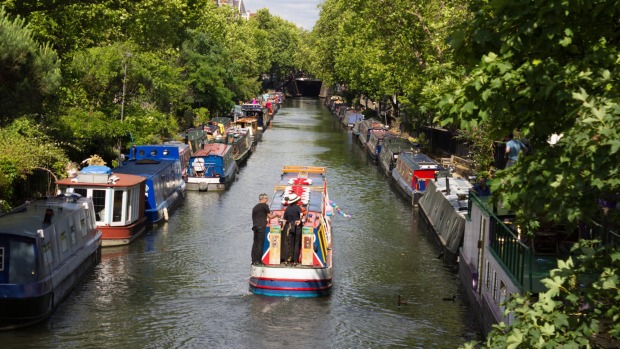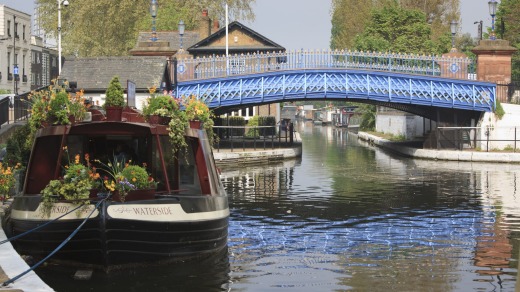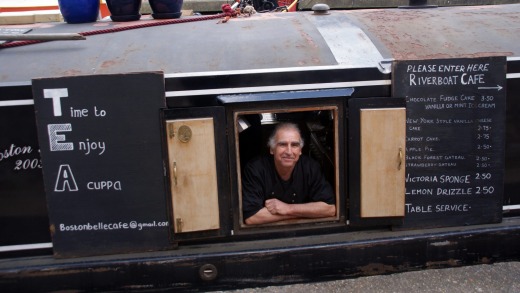
It is a mild sunny morning in east London and there's a lot of tweeting going on. I'm not referring to the communication tools of the trend-setting hipsters who have colonised swathes of this, the British capital's most rapidly-evolving region (nor the chit-chat of Cockney sparrows, those chirpy characters of East End folklore). I'm talking about real birds.
Shooting the gentle breeze from a cluster of spindly sycamores is an animated flock of moorhens, their tiny yellow and red beaks working overtime. Adding to the bucolic soundscape is a singing red-breasted robin, while in the otherwise calm waters below, a paddling of fat ducks bicker, quack and splash. Unflustered by the commotion is an elegant white swan, which glides serenely, and silently, past her unruly web-footed cousins.
Birdlife is just one of the many charming aspects of Regent's Canal, which to many Londoners - and tourists in the know - is the city's most beguiling stretch of water. Named after the Prince Regent (later King George IV), it arches 14 absorbing kilometres between east and west London, cutting through a patchwork of diverse neighbourhoods, from the shabby and austerity-hit to the leafy and exceedingly affluent.

Part of a network of artificial waterways built in the early 19th century to transport goods across Britain, Regent's Canal fell into disuse by the 1960s, as freight was increasingly ferried by road and rail, but it's now enjoying a renaissance as an artery of leisure - one that can be savoured both from the water and its refurbished towpaths.
You can commandeer your own narrowboat - or charter a vessel and skipper - to journey along the canal, but I fancy cycling beside it. It means I can pitstop where I want, when I want - without worrying about finding a mooring space, and without having to navigate the canal's 13 original, hands-on locks (which can each take 10-20 minutes to pass through).
I set off from Limehouse Basin, where the canal connects with the River Thames, three kilometres east of Tower Bridge. Formerly Regent's Canal Dock, it once thronged with vessels from across the world, with Scandinavian ice, Baltic timber and coal from the seaports of Northern England among the wares loaded onto barges and shipped up the canal.

While the basin is now spick and span - sprinkled with glossy yachts and quaint narrowboats and fringed with deluxe apartments, as the skyscrapers of Canary Wharf gleam in the background - the first section of the canal is rather rough and ready, with spartan housing estates and relics of the area's industrial past casting a shadow. I pedal under brick and iron bridges carrying rumbling trains, cars and buses, and pass derelict Dickensian-era warehouses strewn with ivy and graffiti, a free-standing brick chimney (a former sewer ventilation shaft) and giant, skeletal frames of gasometers from defunct coal-fuelled gasworks.
Yet just as the urban grit starts to overwhelm, something idyllic will catch your eye: lush, grassy lawns smothered in blooming daffodils, tree-filled parks alive with birds and squirrels, and beautifully-kept narrowboats capped with potted plants, chopped firewood and watering cans, etched with paintings of kingfishers, dragonflies and countryside cricket games, and flaunting names such as "Idler", "Goldilocks" and "Dreamcatcher''. Canal living has always drawn bohemians, but for others, London's sky-high property prices and rents (including those for the swanky new flats mushrooming beside the canal) mean a narrowboat is often the only viable option for affordable city-centre living. Permanent residential mooring berths are hard to come by, but some folk have managed to set up homes - and hairdressers, cafes and second-hand clothes stores - in their snug, chimney-blessed barges.
Juxtaposed with the canal's contrasting landscapes is its melting pot of visitors. I spy stony-faced joggers in high-visibility vests pounding past well-groomed City slicker-types; mums in black burkas pushing prams past benches upon which scruffy loafers sip cans of beer (and puff on something that smells suspiciously like marijuana); kayakers and canoeists wielding oars and paddles; cyclists steering everything from sleek racers to fixed-gear bikes, and young couples and families holding hands and chatting in a slew of languages (I hear Arabic, Bengali, Hebrew, Spanish, Italian, Portuguese, French, Swahili, Russian and Polish, as well as Australian, Kiwi and Canadian-tinged English).
There are gravelly London accents, too, drifting from a gang of canal maintenance workers transferring litter and broken tree-branches onto a cleaning barge.
"What time is it, bruv?" says one.
"Tea-time!" replies his colleague. "It's 11 o'clock actually, bruv."
You'll hear Mackem rather than Cockney from the canal's first roving cafe owner. A native of Sunderland in England's north-east, Phil Atkinson serves a selection of teas, Lavazza coffee and home-made cakes (think victoria sponge and lemon drizzle) from his purpose-built Boston Belle Riverboat Cafe. The only problem is trying to find it.
"We have to move every two weeks," says Phil, referring to the temporary mooring rules that stipulate boaters must not be in any one spot for more than 14 days. "But when we're really busy, we run out of water [which we store in stainless steel tanks] after a week. So we have to restock our supplies then find a suitable new place to moor."
Today, Atkinson's barge is a few minutes' bike ride from Camden. While much of the canal route is blissfully calm, the noise and aromas from tourist-clogged, seven-days-a-week Camden Market are a jolting reminder that we're in the city. Spread across a former timber yard hugging the water are street food stalls selling an assortment of dishes - including Polish, Thai and Malay - plus several canal-side pubs and restaurants.
If you'd prefer refreshments in more placid surrounds, it's best to stop at the Narrow Boat, a cosy gastro-pub overlooking the canal at Islington (four kilometres east of Camden), or at the cluster of al fresco cafes and arts venues on the so-called Haggerston Riviera (between De Beauvoir Town and Hoxton). Drawing an eclectic clientele - from bearded chaps in skinny jeans discussing London's latest pop-ups and craft brews to grannies doing their newspaper crosswords - the riviera's Towpath cafe is ideal for sipping flat whites and watching the world go by (though, like much of the canal, it gets pretty crowded on warm-weather weekends).
A glass-fronted Mediterranean establishment, Cafe Laville is great for a long lazy lunch. It's perched over the last, and perhaps loveliest, stretch of the canal at Maida Vale - about 500 metres from Little Venice, where the Regent's Canal meets the Grand Union Canal, a waterway that snakes up to Birmingham.
Edged by peaceful gardens, weeping willows and handsome stucco mansions, Little Venice has some of London's most desirable addresses (Sigmund Freud, Ruth Rendell, Marc Bolan, Kate Moss and Paul Weller are among residents, past and present). It's a fine place to end your ride: you can take afternoon tea at the Waterside Cafe, watch a show at the Puppet Theatre Barge (anchored here since 1982), or hop on a canal cruise (as well as daytime pleasure jaunts, there are twilight water-borne dinner and disco experiences to be had).
But, after a little rest, you may, like me, prefer to get back on the towpath. There's so much to see and do along Regent's Canal - and so many things you miss first time around - that repeat visits are highly recommended. Especially now, when the days are long and the sun is (usually) shining.
FIVE PITSTOPS ALONG REGENT'S CANAL
1. MUSEUMS. Housed in a former ice store near King's Cross, the London Canal Museum traces the heritage of Regent's Canal and the capital's other artificial waterways. Offering an insight into the Victorian East End, the Ragged School Museum occupies the Copperfield Road premises where Dr Barnardo fed and educated poor and orphaned children in the late 1800s.
2. PARKS. Regent's Park is the most famous of the green lungs edging the canal, but don't miss Victoria Park, which borders the districts of Bethnal Green, Hackney and Bow. You'll find sports facilities and children's play areas, a boating lake (with rowing boats and pedalos for hire), a pavilion cafe, a Chinese pagoda, tree-lined walks and picnic-friendly lawns.
3. MARKETS. Tucked off the canal between Victoria Park and Haggerston, Broadway Market is one of East London's coolest hangouts. On Saturdays, this deli-and-cafe-lined stretch is jammed with sizzling food and craft stalls. Less hip - it's been running for more than a century - is the Saturday Kingsland Waste bric-a-bric market in Dalston (turn right at Kingland Road bridge).
4. LONDON ZOO. Close to the turn-off for well-heeled village Primrose Hill, the canal skirts the perimeters of London Zoo. You'll see exotic birds flying in cages from the towpaths, but to peruse gorillas, tigers and Galapagos tortoises (and more), you'll need to lock up your bike and pay to enter the zoo.
5. LORD'S CRICKET GROUND. The "Home of Cricket" actually had to move 200 metres to make way for the canal's construction (it's now at the western edge of Regent's Park). You can watch matches from April to September, take year-round behind-the-scenes tours and visit the memorabilia-packed MCC Museum. A two-minute ride from Lord's is The Beatles' iconic Abbey Road crossing.
TRIP NOTES
GETTING THERE
Qantas, Emirates and Singapore Airlines are among the airlines that fly between Sydney and Melbourne and London.
CYCLING THERE
London Bicycle Hire Company in Gabriels Wharf, Southbank, lends a range of bicycles, from $39 a day; londonbicycle.com.
Dubbed "Boris bikes" after London's bicycle-riding mayor Boris Johnson, Santander Cycles (formerly Barclays Cycles) leases three-speed bikes at docking stations across the city (including at Limehouse DLR station, near Limehouse Basin, and Warwick Avenue tube, near Little Venice). Costs vary depending on usage. See tfl.gov.uk.
The canal disappears under tunnels, with no towpath, in two short stretches near Maida Vale, and a longer one, the 879-metre Islington Tunnel, when you'll need to detour through the buzzing streets of Angel district.
Redevelopment projects around King's Cross means a section of the canal towpath has been temporarily closed, so you'll have to wheel your bicycle along "wobbly" boardwalk replacement bridges for a few hundred metres. The works are expected to finish in 2016.
MORE INFORMATION
Jason's Cruises and Floating Boater both run canal cruises from Little Venice; jasons.co.uk, floatingboater.co.uk
Haggerston Riviera: haggerstonriviera.co.uk visitbritain.com.